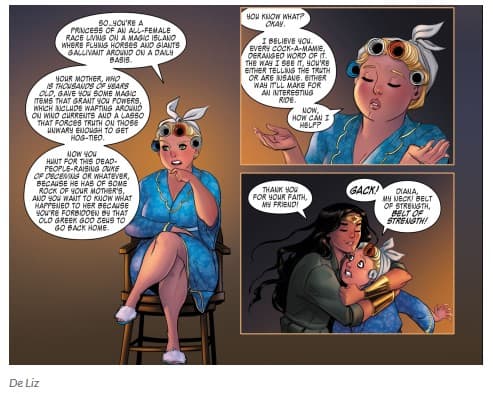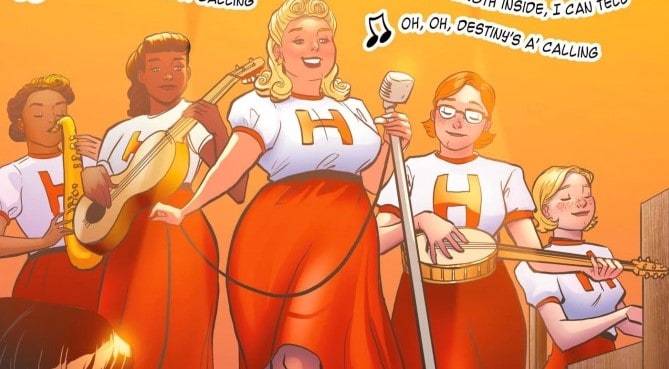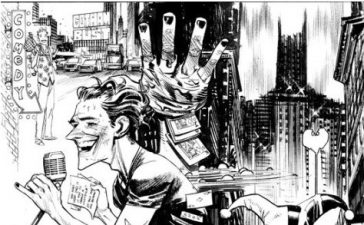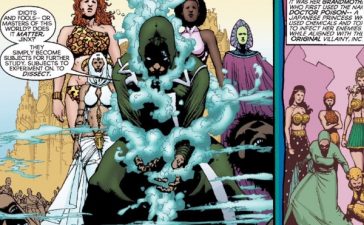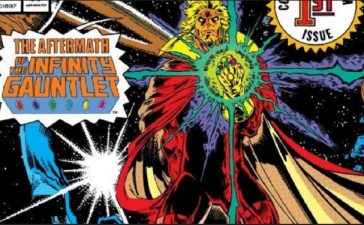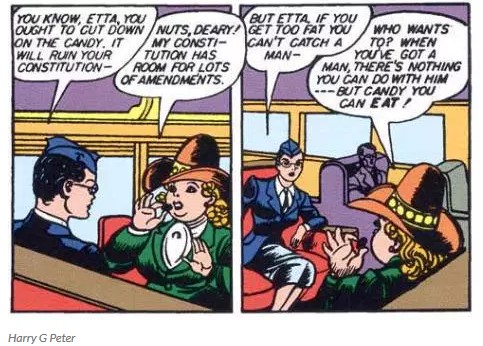
On October 21st, the United Nations named Wonder Woman their honorary ambassador for the empowerment of women and girls. Diana was cited for her decades long commitment to “justice, peace and equality,” all virtues which have defined the character since her 1941 debut. DC and their parent company Warner Brothers proudly celebrated the UN’s distinction, rolling the ceremony at the United Nations headquarters into another segment of their ongoing commemoration of Diana’s 75th Anniversary this year and promotion for her first solo film in 2017. Wonder Women past and present, Lynda Carter and Gal Gadot, were prominently featured at the festivities. Wonder Woman director Patty Jenkins attended, as did DC artist/executive Jim Lee. Noticeably absent though were any decedents of Wonder Woman creators William Moulton Marston and Harry G. Peter. The lack of acknowledgement for their pioneering work should not come as surprise given DC’s decidedly mixed track record honoring their legacy.
However, there were more controversies roiling the halls than The Big Two’s continued stumbles with acknowledging creators and their families. Many criticized the organization’s choice of a fictional character to represent gender equality. Such a choice is not without precedent, as in the past Winnie the Pooh was chosen as ambassador of friendship, Red from Angry Birds ambassador of happiness and, in something that sounds like a rejected Grant Morrison Animal Man pitch, Tinker Bell ambassador of “green.” The more substantive compliant was leveled at Wonder Woman herself and whether her idealized figure was counterproductive in bolstering female self-esteem. Body image issues have long been a problem for the comics industry; anyone reading comics in the 90s could easily see how little effort it took to leap over the line dividing empowerment from objectification. In recent years, publishers have become more attentive to such concerns, as the voices of female fans and creators have grown stronger. Yet, the question remains: in a cultural moment marred by virulent sexism and rising teenage girl suicide rates, is a super-powered, sometimes demigod, heroine with a supermodel-like figure really the best role model? Does her appearance undercut those values she strives so hard to achieve? As is often the case with Wonder Woman, the best answer is found within the work of her creators.
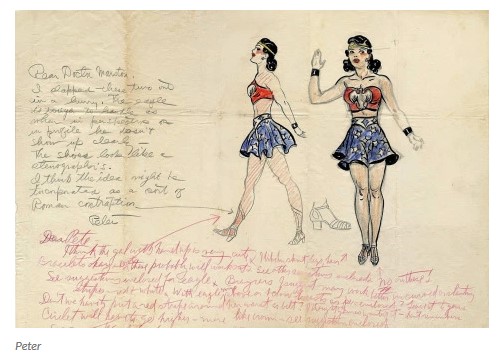
Marston and Peter worked together on the initial designs for Wonder Woman; Marston would provide notes on what visual elements he valued, Peter would sketch them, Marston would critique and so on. Jill Lepore’s The Secret History of Wonder Woman examines this process as writer and artist figure out what works best. (At one point, Peter gave Wonder Woman a blouse with a high collar, a choice Marston dismissed as potentially dating too quickly). Both men had backgrounds in the suffragette movement so that they were fully versed in feminist iconography. At the same time, they were not working for a political pamphleteer but a commercial periodical. Publisher Charlie Gains liked the bullet stopping bracelets (which could also stop the gun-violence related concerns initial issues of Batman had raised) and all the patriotic imagery (which had assisted in making Captain America’s debut earlier that year so successful). At the same time, the idea for Wonder Woman’s tiara was borrowed from the Miss America beauty pageant and Gaines expressed a preference that the new heroine be as scantily clad as allowable. Peter drew some of his inspiration from the pinups of Alberto Vargas, whose art got Esquire magazine condemned by the U.S. Post Office for indecency. Marston might have declared Wonder Woman “wise as Athena” and “stronger than Hercules” but “beautiful as Aphrodite” as well. As with any enduring socio-political commentary, a healthy bit of contradiction was built into the concept from the start.
Despite all this, Marston was not blind to the subject of body image and early on made it a prominent part of his feminist message. One of the key supporting players of the Marston years is Etta Candy. Etta debuted in one of Diana’s earliest adventures, Sensation Comics #2 (1942). Seeking help in rescuing Steve Trevor from the clutches of Dr. Poison, Wonder Woman turns to a former patient of her alter ego Nurse Diana Prince. Etta is currently a student at Holliday College where she leads the school’s all girl marching band. At first Diana is surprised by Etta’s full-bodied figure, remembering her as thin. Etta explains that after her appendix was removed, she was able to indulge her appetite freely. Recalling Nurse Prince’s care during Etta’s hospital stay, Etta proclaims “I’d do anything for (Nurse Prince)—except diet.” Thus, Etta rounds up volunteers for Wonder Woman, readily taking charge of logistics. The involvement of Etta and the ladies of Holliday College prove crucial to winning the day, which sets the pattern for later stories. When Wonder Woman needs a last minute assist, it is Etta who lends a hand. Steve often fights side by side with Wonder Woman, but is never vital to her victories as Etta is.
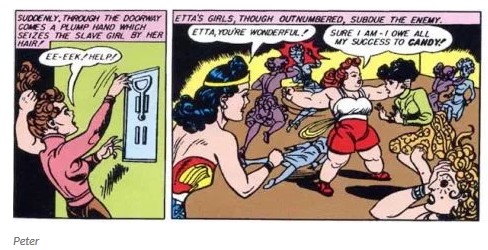
This fact is important in elevating Etta beyond type. Etta does often serve as a comic counterpoint in Marston’s narratives, which includes jokes related to her devotion to sweets. (Her parents are Hard and Sugar Candy, and, yes, if your mind is straying there, Marston’s most likely was as well). However, the humor is never made at Etta’s expense; the reader laughs with Etta, never at her. This is an important distinction, as seven decades later weight remains a shortcut for comedy. Too often the archetype of the bumbling, jolly, plumb, dim sidekick is lazily employed in stories. Marston undercuts all of this. Yes, his Etta does have a bright personality, which is immediately infectious. Etta is an optimist who rarely, if ever, sees cause for discouragement. She possesses a perseverance which makes her more reliable than Steve Trevor’s well-meaning, but not always dependable puppy love. Steve can be a bit of a dope. Etta on the other hand, is smart and not simply in the traditional fields of female learning. More than one story highlights Etta’s scientific intelligence. Taken together, she serves as striking role model for the young women reading Wonder Woman. Along with the other ladies of Holliday College, Etta Candy is a reminder that women do not need to be a super powered Amazon in order to make a difference; they do not need to look like a movie star in order to fight for justice. All they need is the resolution and pep of Etta Candy in order to be as much a heroine as any Wonder Woman.

If Etta Candy is a strong reminder of how radical Marston’s work for Wonder Woman was, she sadly also serves as sad reminder for DC’s failure to fully honor that vision. Marston maintained tight control of Wonder Woman’s solo adventures. Unfortunately on May 2nd 1947, he died from cancer at the age of 53. One of his widows Elizabeth Holloway (Holliday College was most likely named for her) lobbied DC for the continuation of Marston’s vision. She proposed that she assume a position overseeing the character and when that failed sent the publisher unsolicited treatises on how best to portray Wonder Woman. DC ignored her. Instead, they handed the series to Robert Kanigher who proceeded to strip Diana of her feminist fashions. This editorial thinking should not be surprising given how Gardner Fox had been belittling Wonder Woman over in the pages of Justice Society of America. Without the force of Marston’s personality to defend his vision, Wonder Woman reverted to type and Etta along with her. Where Marston’s Etta proclaimed body positivism, Kanigher’s became preoccupied with weight loss. Kanigher openly disliked the character and wrote her out of the series. Other writers would return to her over the years but it was Kanigher’s revisionist treatment that served as their starting point. This trend marred Etta’s largest spotlight to date: her appearance on the first season of the 70s Wonder Woman television series. As portrayed by Beatrice Colen, Etta is a ditz who serves little purpose beyond comic relief. A self-confidant leader of women she clearly no longer was.
The TV show’s most lasting influence on the character was promoting her from college student to army officer, even though her duties were primarily secretarial. A few years later when Etta was reintroduced in the comics, she now had a place in the military hierarchy. It was this recent reinvention of the character George Perez and Len Wein used as the starting point for their conception of Etta for their iconic post-Crisis on Infinite Earths reimagining of Wonder Woman.
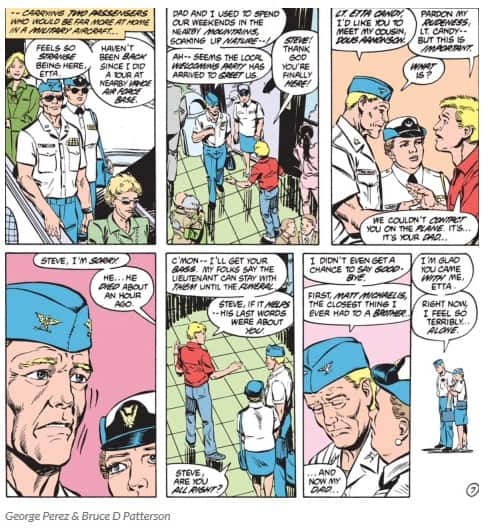
On the surface, the change in Etta’s status to army officer is an interesting one, which does give her a more naturalistic reason to be involved in Diana’s adventures. The problem, at least in the first 14 issues of the run, is that Etta does not actually participate that much in the action of the narrative. She mostly fades into the background letting Steve engage in the daring do. Even more discouraging is Etta’s disposition which lacks the sass of her Golden Age counterpart. Her personality is dour, almost perpetually in a funk. She speaks little, preferring to listen kindly while Steve expresses his concerns. Instead of defiantly blazing her own path, she is there to prop up the man. In one issue her most memorable dialogue consists of complimenting Steve’s mom on making a special “diet plate” for her, Etta’s, dinner. Thus, Perez and Wein completely flip the gender dynamics from Marston’s radical boundary pushing to something more in aligned with 80s conservatism. In addition, they decide to make Steve and Etta a couple which is about as appealing as watching Lois Lane hookup with Jimmy Olsen. Over time, other artists would slim down Etta’s figure, giving her a more conventionally generic appearance. Unfortunately many of these same faults can be identified in her use in the current Greg Rucka Rebirth run. Even in 2016, DC seems unable to embrace the feminism of Marston’s 40s narratives.
Part of this hesitance could be the fault of larger trends within the industry. The late 80s saw a shift away from the wackier side of superheroes, as creators delved into grittier, more relatable stories. Perhaps Perez, Wein and those who came after them viewed Marston’s Etta as too much a relic of Golden Age outlandishness. Yet, comics are inherently an outlandish enterprise. Drip it in as much shadow and grime as you want, but there is still something absurd about Daredevil and Bullseye dressed in full body spandex, bouncing around New York rooftops, tossing Billy clubs and playing cards at each other. Present series such as The Unbeatable Squirrel Girl demonstrate how delightful embracing the whimsical side of comics can be. It is probably not a coincidence that one of the few aspects of Wonder Woman Grant Morrison got right in his Earth One graphic novel was Etta Candy. Morrison, never shy of diving headlong into the ridiculous, demonstrated that sassy Holliday College student Etta Candy can still be a believable part of Diana’s modern day adventures.
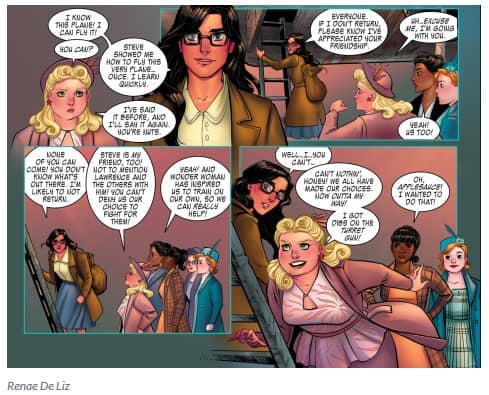
Even better is Renae De Liz’s recent digital series The Legend of Wonder Woman. While set during the World War II period, De Liz does an excellent job in blending contemporary sensibilities with Marston’s original vision. Once again Etta Candy is the strong-willed, resourceful, perky woman readers of Marston remember so fondly. Some tweaks are made. For example, instead of leading a marching band, she is singing lead vocals in a pop/jazz group. Etta now has now more of an interest in fashion than science. However, the spirit of the character remains the same. She is not only a smart, brave companion for Wonder Woman, but a positive example for a new generation of young readers. Most importantly, De Liz sweeps away all the deferential, body-conscious traits that have accumulated around the character since Marston’s passing. In De Liz’s hands fans once more have a reminder that they do not need to look like an Amazon in order to be a heroine. All they need is the determination to fight for what they value. And sadly that message is as essential now as it was seventy-four years ago when Etta Candy first charged into battle at Diana’s side.
